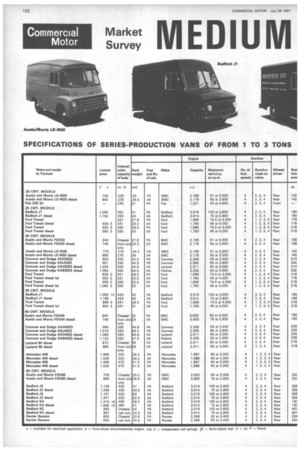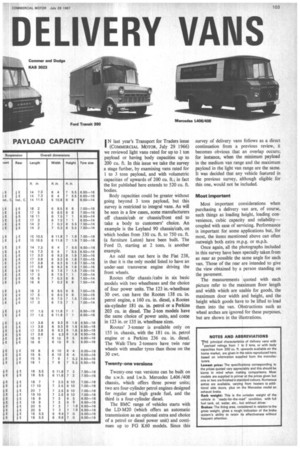Market MEDIUM
Page 104

Page 105

If you've noticed an error in this article please click here to report it so we can fix it.
survey
DELIVERY VANS
I N last year's Transport for Traders issue (COMMERCIAL MOTOR, July 29 1966) we reviewed light vans rated for up to 1 ton payload or having body capacities up to 200 cu. ft. In this issue we take the survey a stage further, by examining vans rated for 1 to 3 tons payload, and with volumetric capacities of upwards of 200 cu. ft.; in fact the list published here extends to 520 Cu. ft. bodies.
Body capacities could be greater without going beyond 3 tons payload, but this survey is restricted to integral vans. As will be seen in a few cases, some manufacturers off chassis/cab or chassis/front end to take a body to customers' choice. An example is the Leyland 90 chassis/cab, on which bodies from 330 cu. ft. to 750 cu. ft. (a furniture Luton) have been built. The Ford D, starting at 2 tons, is another example.
An odd man out here is the Fiat 238, in that it is the only model listed to have an under-seat transverse engine driving the front wheels.
Rootes offer chassis/cabs in six basic models with two wheelbases and the choice of four power units. The 123 in.-wheelbase 30 cwt. can have the Rootes 138 cu. in. petrol engine, a 160 cu. in. diesel, a Rootes six-cylinder 181 Cu. in. petrol or a Perkins 203 cu. in diesel. The 2-ton models have the same choice of power units, and come in 123 in. or 135 in. wheelbase sizes.
Rootes' 3-tanner is available only on 155 in. chassis, with the 181 cu. in. petrol engine or a Perkins 236 cu. in. diesel. The Walk-Thru 2-tonners have, twin rear wheels with smaller tyres than those on the 30 cwt.
Twenty-one versions
Twenty-one van versions can be built on the s.w.b. and I.w.b. Mercedes L406 /408 chassis, which offers three power units; two are four-cylinder petrol engines designed for regular and high grade fuel, and the third is a four-cylinder diesel.
The BMC range of vehicles starts with the LD-M20 (which offers an automatic transmission as an optional extra and choice of a petrol or diesel power unit) and continues up to FG K60 models. Since this survey of delivery vans follows as a direct continuation from a previous review, it becomes obvious that an overlap occurs; for instance, when the minimum payload in the medium van range and the maximum payload in the light van range are the same. It was decided that any vehicle featured in the previous survey, although eligible for this one, would not be included.
Most important
Most important considerations when purchasing a delivery van are, of course, such things as loading height, loading convenience, cubic capacity and reliability coupled with ease of servicing. Performance is important for some applications but, for most, the items mentioned above can often outweigh both extra m.p.g. or m.p.h.
Once again, all the photographs included in this survey have been specially taken from as near as possible the same angle for each van. Those of the rear are intended to give the view obtained by a person standing on the pavement.
The measurements quoted with each picture refer to the maximum floor length and width which are usable for goods, the maximum door width and height, and the height which goods have to be lifted to load them into the van. Obstructions such as wheel arches are ignored for these purposes, but are shown in the illustrations.




































































































































































